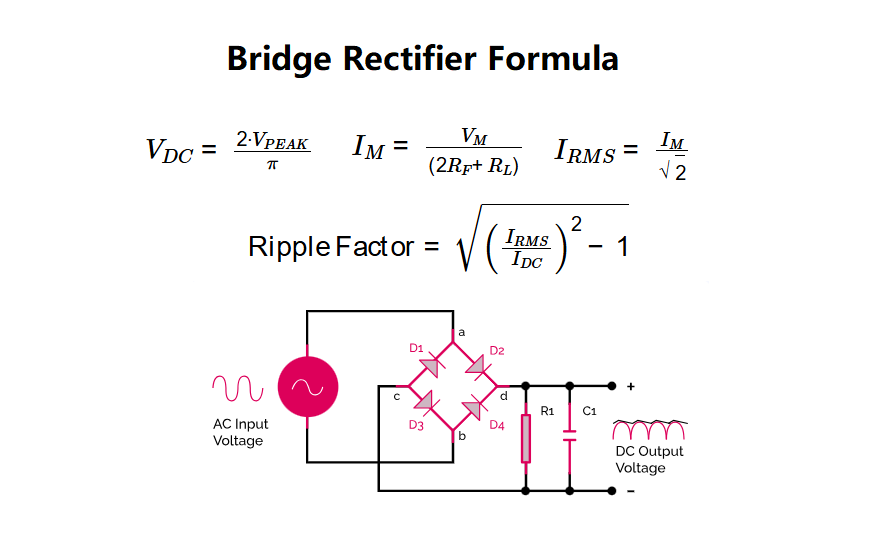1. What is Bridge Rectifier Calculator?
Definition: This calculator computes key parameters of a bridge rectifier circuit, which converts AC voltage to DC voltage. It offers four modes: calculating the DC output voltage (\( V_{DC} \)), the maximum current (\( I_M \)), the RMS current (\( I_{RMS} \)), or the ripple factor.
Purpose: It is used in electronics to design bridge rectifier circuits for applications like power supplies, ensuring proper voltage, current, and ripple characteristics for components.
2. How Does the Calculator Work?
The calculator supports four modes:
DC Voltage Mode:
\( V_{DC} = \frac{2 \cdot V_{PEAK}}{\pi} \)
Where:
- \( V_{DC} \): DC output voltage (V)
- \( V_{PEAK} \): Peak AC voltage (V)
Maximum Current Mode:
\( I_M = \frac{V_M}{(2 R_F + R_L)} \)
Where:
- \( I_M \): Maximum current (A)
- \( V_M \): Maximum AC voltage (V)
- \( R_F \): Forward resistance of the diodes (Ω)
- \( R_L \): Load resistance (Ω)
RMS Current Mode:
\( I_{RMS} = \frac{I_M}{\sqrt{2}} \)
Where:
- \( I_{RMS} \): RMS current (A)
- \( I_M \): Maximum current (A)
Ripple Factor Mode:
\( \text{Ripple Factor} = \sqrt{\left(\frac{I_{RMS}}{I_{DC}}\right)^2 - 1} \)
Where:
- \( I_{RMS} \): RMS current (A)
- \( I_{DC} \): DC current (A)
Steps:
- Select the calculation mode (DC Voltage, Maximum Current, RMS Current, or Ripple Factor).
- Enter the required inputs with their units (e.g., voltage, resistance, current).
- Convert inputs to base units (V, Ω, A).
- Calculate the result using the appropriate formula.
- Convert the result to the selected output unit (if applicable).
- Display the result with 4 decimal places.
3. Importance of Bridge Rectifier Calculation
Calculating bridge rectifier parameters is crucial for:
- Electronics Design: Ensuring the correct DC voltage, current, and ripple characteristics for powering circuits.
- Component Selection: Choosing diodes and resistors that can handle the maximum current and voltage.
- Efficiency: Optimizing the rectifier circuit for minimal power loss and acceptable ripple.
4. Using the Calculator
Example 1 (DC Voltage Mode): An AC source with a peak voltage of 170 V:
- Peak AC Voltage (\( V_{PEAK} \)): 170 V
- DC Voltage (\( V_{DC} \)): \( \frac{2 \times 170}{\pi} \approx 108.2250 \) V
- Result: \( V_{DC} = 108.2250 \) V
Example 2 (Maximum Current Mode): An AC source with a maximum voltage of 170 V, a load resistance of 100 Ω, and a forward resistance of 10 Ω:
- Maximum AC Voltage (\( V_M \)): 170 V
- Load Resistance (\( R_L \)): 100 Ω
- Forward Resistance (\( R_F \)): 10 Ω
- Maximum Current (\( I_M \)): \( \frac{170}{(2 \times 10) + 100} = \frac{170}{120} \approx 1.4167 \) A
- Result: \( I_M = 1.4167 \) A (or 1416.6667 mA)
Example 3 (RMS Current Mode): A maximum current of 1.4167 A:
- Maximum Current (\( I_M \)): 1.4167 A
- RMS Current (\( I_{RMS} \)): \( \frac{1.4167}{\sqrt{2}} \approx 1.0017 \) A
- Result: \( I_{RMS} = 1.0017 \) A (or 1001.6667 mA)
Example 4 (Ripple Factor Mode): An RMS current of 1.0017 A and a DC current of 0.9 A:
- RMS Current (\( I_{RMS} \)): 1.0017 A
- DC Current (\( I_{DC} \)): 0.9 A
- Ripple Factor: \( \sqrt{\left(\frac{1.0017}{0.9}\right)^2 - 1} \approx 0.4940 \)
- Result: Ripple Factor = 0.4940
5. Frequently Asked Questions (FAQ)
Q: What is a bridge rectifier?
A: A bridge rectifier is a circuit that converts AC voltage to DC voltage using four diodes arranged in a bridge configuration, commonly used in power supplies.
Q: What is the ripple factor?
A: The ripple factor measures the AC component (ripple) in the rectified output relative to the DC component. A lower ripple factor indicates a smoother DC output.
Q: Why is RMS current important?
A: RMS current is used to calculate the effective current in AC circuits, which is important for determining power dissipation and component ratings in the rectifier circuit.
Bridge Rectifier Calculator© - All Rights Reserved 2025
 Home
Home
 Back
Back
